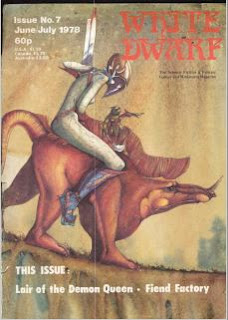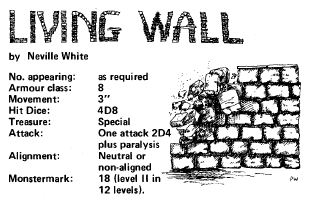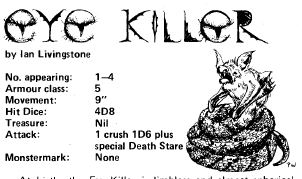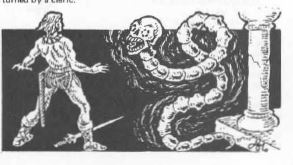By Issue 7, White Dwarf is now a year old, and this is its first colour cover. Hurrah.
First up is Gary Ames’ Rover, as seen in The Prisoner; a bouncy blob-ball thing that traps victims inside it and suffocates them. I mean, it is what it is, I guess. They were daft in The Prisoner except for a few occasions where they showed a kind of creepy intelligence by lurking aound corners.
And talking of daft, Neville White’s Living Wall is described as being a relative of the gelatinous cube. The description is sometimes oddly in the past tense “its attack was a paralising [sic] effect” which makes me assume that Don simply plonked Neville’s writing straight into the column without, you know, editing. Why not just use a gelatinous cube? Or a mimic? Seems redundant to me to have a new creature for every bit of dungeon architecture. This made it into the Fiend Folio as the Stunjelly, which I can’t give a picture because that page of my PDF is corrupted.
It makes me wonder though. Could one make a dungeon room where everything was an official monster? Stunjelly walls, Lurker Above roof, Trapper floor, Mimic or Animate Item furniture….
Wot Larks.
I quite like the simplicity of Jonathon Jones’ Volt, a little flying creature that sucks your blood and zaps you with its electric stinger tail. Nothing particularly gimmicky, just a cross between a stirge and a stingray, really. It probably helps sell this one that they managed to get the mighty Erol Otus to do the illustration for the Fiend Folio. Since I’ve included them in the Book of Lost Monsters, I’m not going to stat these ones up here.
Another one that got a (merciful) name change when it went into the Fiend Folio, Guy Shearer’s Gluey becomes known as the Adherer, a monster that looks like a mummy but is in fact not undead, but something with an adhesive skin. I’ve never quite understood the mummy-a-like aspect, except that it’s one of those early “dungeon creatures” that is supposed to trick experienced players (like the gas spore). Actually, I quite like the idea of a creature where your weapons get stuck, I just don’t see why it needs to (a) look like a mummy and (b) that’s its only reason to exist. A magnet golem might be fun.
Another seemingly pointless creature, Christopher Kinnear’s Squonk is an ugly, warty, rodent that cries because it’s so ugly. Hey. Eye of the beholder and all that. It doesn’t do much apart from cry, but it is completely impervious to magic and might befriend a kind party. Don Turnbull rather patronisingly asserts that “perhaps the female D&Ders would take more to this beast than the hard-headed males”. Different times, folks, different times. Now, put the kettle on, love.
Big Boss Ian Livingstone returns with the Eye-Killer, a kind of half-bat, half-snake thing that can focus ambient light into a deadly beam, one of those “save or die” monsters. I’m not sure here that the original White Dwarf picture isn’t better than Alan Hunter’s version for the Fiend Folio, with its really ineffective wings (the creature doesn’t fly, though. Like the remorhaz, these are for helping it rear up).
This is another one that I’ve converted for the Book of Lost Monsters. Not being fond of instant death effects, I changed the death ray into a big handful of radiant damage. It’ll still cause death to weakened creatures, but not necessarily instant. This is possibly another "real" cryptobeast as you get them in Shadowrun as well - a form of Awakened owl.
Simon Eaton’s Witherweed made it into the Fiend Folio, but doesn’t get a picture. It’s more of an environmental feature than a monster, like Green Slime or Yellow Mould. And for that, it’s not a bad option. It has fronds that drain Dexterity (attribute loss is unusual but not unheard of in 5th Ed., for example see the Shadow), and if burned it gives off toxic smoke.
I
might even write this up as a secondary concept.
The last in the batch is Don Turnbull’s own Withra, which he didn’t include in the Fiend Factory that he edited, possibly not wishing to appear biased, possibly because it’s a daft idea, typical of the earlier “puzzle dungeon” style of play. It’s a wraith that went wrong, and so raises levels rather than drains them, is immune to turning and is vulnerable only to normal weapons. It has the word “reject” written in Chaotic on the back of its neck (remember when alignment language was a thing?)
I’ll let Don’s comments speak for themselves.
Monsters giving the new employee an orientation session. That’s up there with the secret break room where all the wandering monsters hang out until they’re needed. Fun in the right kind of hands, once in a while.
Which leaves us with, the Necrophidius by Simon Tilbrook. A simple idea, with a distinctive appearance, and reasonable and logical powers. As I recall, either Paizo or Dungeon magazine bought these back for 3rd Edition in one of the Adventure Paths (I checked, and the first adventure in the Paizo series Curse of the Crimson Throne features the necrophidius, but this is from Tome of Horrors Revised). Because, frankly, they’re good monsters.
Also, with the White Dwarf version, you get a nice little bit of back-story as well, which I always like. One wonders if Karalkan, creator of the necrophidius, knew the alchemist Vollan who accidentally made the Spinescales?
Again, I think the original illustration (by Polly Wilson) is better than what Alan Hunter drew for the Fiend Folio.
The first thing to decide with the necrophidius is whether to make it undead (as per the original entry) or construct (as per the Fiend Folio)? I went with construct, because notes on turning are absent from the original, and the animating principle doesn’t appear to be necrotic energy as such. Also, I already did an undead snake back with the Death Snake in Issue 4. It doesn’t matter too much (unlike 3rd Edition, the different creature types don’t have different stat progressions), so go with whichever feels best.
Hit Dice was a problem too – the necrophidius is plainly a Large creature (it says so in the Fiend Folio, and if it uses a giant snake skeleton it has to be pretty big), but it only gets 2d8 HD originally, which suggests a low-level Medium creature. I bumped the number of HD up a bit, but for 5th Ed. that’s still a relatively low number.
The rest is pretty straightforward, I think. Because the creature is described as “totally silent” I thought that warranted a particular ability, although I also gave it double proficiency Stealth as well. The paralysing bite is likewise simple to create. As for the signature ability, the Dance of Death, there’s nothing obvious in the original stats about how often this can be achieved, although since it seems to only do so if it gets surprise, I think a once per day limit is okay. Or you could revert to it only using it if it gets surprise, which will amount to the same thing. It looks like the hypnotic effect lasts only as long as the necrophidius dances, and will end if it takes any other action.
And there we go:
|
Necrophidius |
||||||||||||
|
Large construct, unaligned |
||||||||||||
|
Armour
Class 13 Hit
Points 39 (6d10 + 6) Speed 30 ft., climb 30 ft. |
||||||||||||
|
||||||||||||
|
Proficiency
Bonus +2 Skills Stealth +7 Damage
Immunities poison Condition
Immunities charmed, exhaustion, frightened, poisoned,
stunned, unconscious Senses darkvision 60 ft., passive Perception 10 |
||||||||||||
|
Languages understands the language of its creator, but cannot speak |
||||||||||||
|
Challenge 3 (700 XP) |
||||||||||||
|
Silent Movement. The necrophidius makes absolutely
no noise as it moves and cannot be detected by hearing alone. ACTIONS |
||||||||||||
|
Bite. Melee Weapon
Attack:
+5 to hit, reach 10 ft., one target. Hit:
7 (1d8 + 3) piercing damage and if the target is a creature it must make a DC
11 Constitution saving throw or become magically paralysed for 10 minutes. A
paralysed creature can repeat the saving throw on each of its turns, ending
the effect on itself with a success. Dance of Death (1/day). The necrophidius begins to sway hypnotically. All
creatures within 60 feet that can see it must make a DC 11 Wisdom saving
throw or become stunned as long as the necrophidius sways. It can continue
this action as if concentrating, but must cease swaying in order to attack. |















Comments
Post a Comment